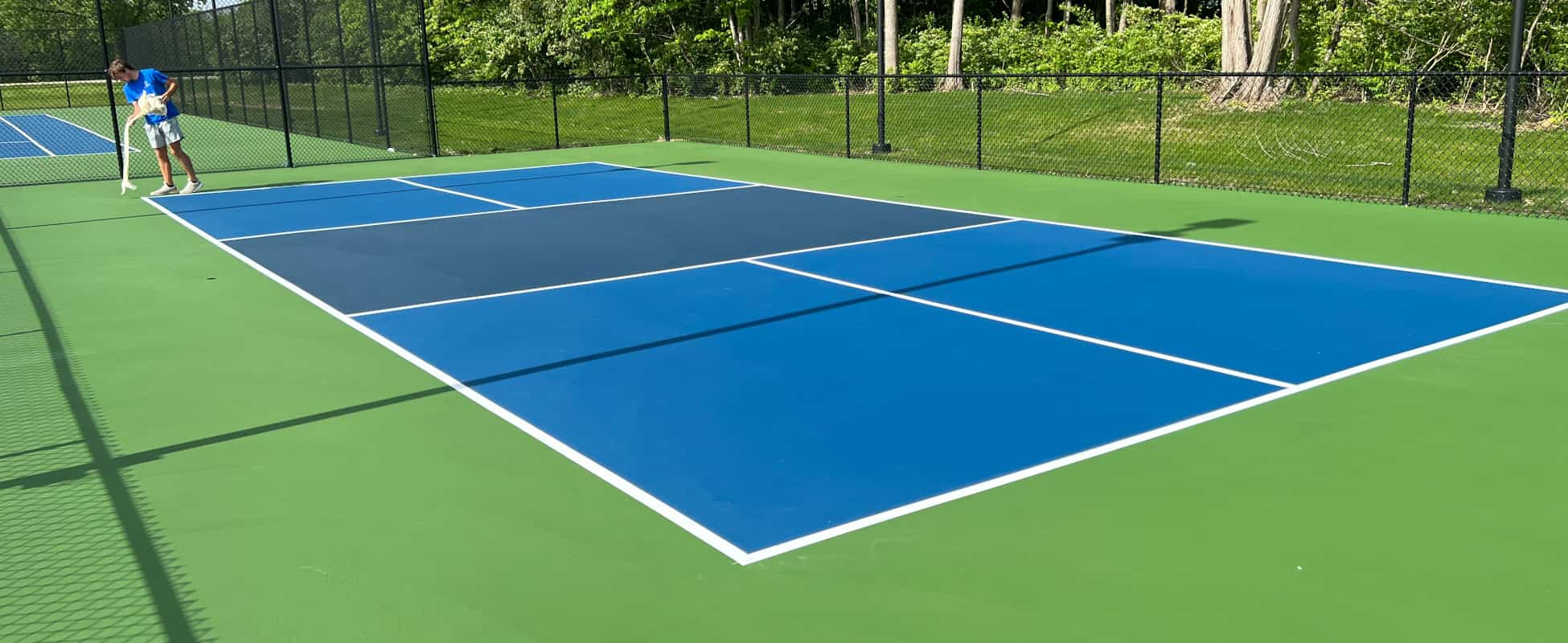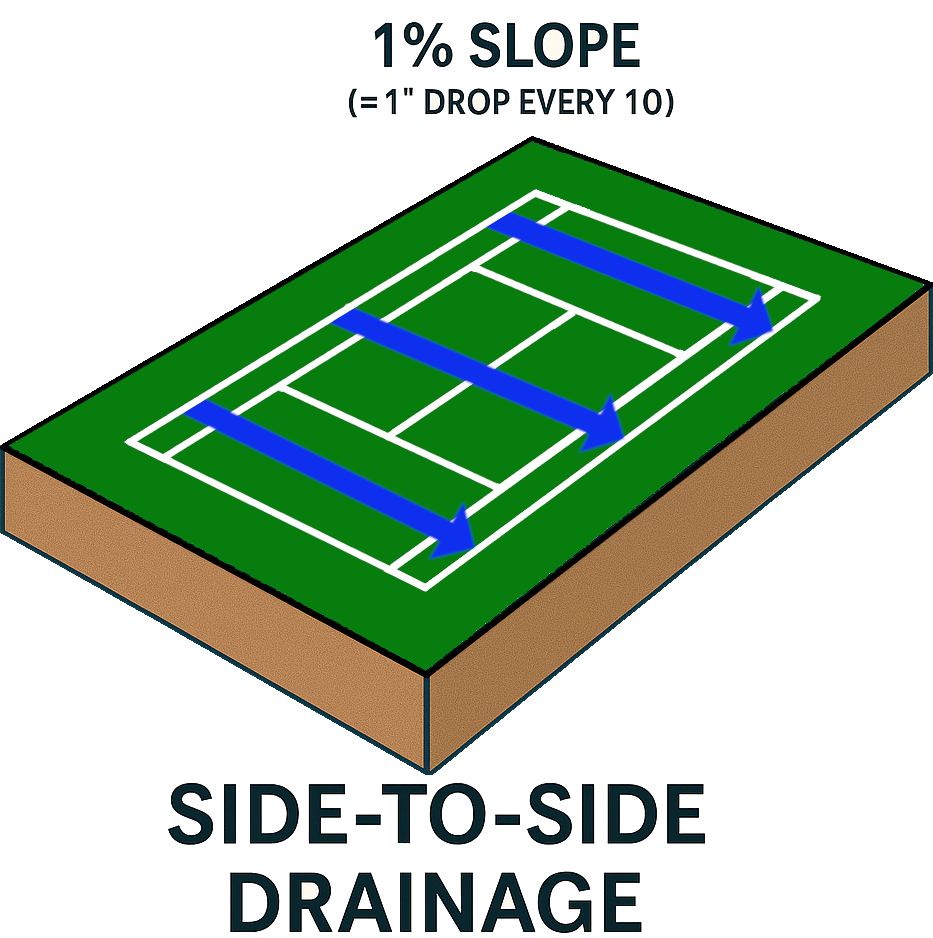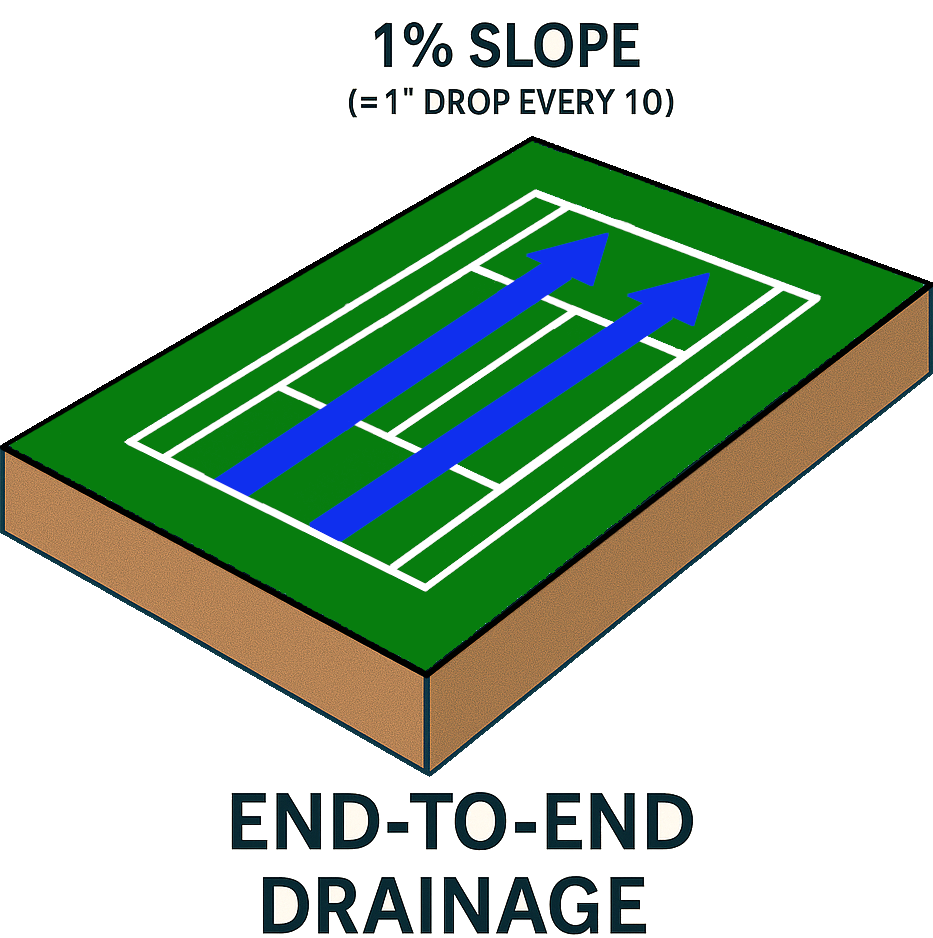Menu

Standing water is one of the fastest ways to ruin a sports court. It damages coatings, weakens the surface, and shortens the life of the installation. Whether you’re building a new pickleball court or resurfacing an existing tennis court, proper drainage should be one of the first design considerations—not an afterthought.
At AG Sports Surfaces, we’ve seen firsthand how good drainage keeps courts safe, playable, and beautiful for years. Here’s what you need to know about drainage requirements for outdoor hard courts in climates like Indiana’s.
Drainage isn’t just about keeping puddles off the surface. When water sits on a court, it slowly seeps into cracks and coatings, causing peeling, soft spots, and structural damage beneath the surface. Over time, that leads to costly repairs—or full replacement far sooner than expected.
Poor drainage also creates safety issues. Standing water makes surfaces slippery, and during freeze–thaw cycles, it can lead to heaving and cracking that affect ball bounce and footing. Proper design ensures that water drains quickly and consistently, protecting your investment and extending the lifespan of your court.
For most hard courts, the goal is to create a smooth, uniform slope that directs surface water off the playing area without affecting play. The goal is to have the water travel the least amount of distance to the drainage.
• Standard slope: 1% (about 1 inch of drop for every 10 feet of length)
• Acceptable range: 0.83% to 1%, depending on court type and site conditions
• Maximum slope: 1% — anything steeper can make the surface feel uneven during play
Courts should be graded in a true plane—no dips, ridges, or uneven sections where water could collect.
There are two main ways a court can be sloped:
• Side-to-side: The surface tilts slightly from one sideline to the other, so water drains evenly across the width of the court. This is the most common design for single and double court installation. Additionally, this is the least noticeable to players.

• End-to-end: The court gently slopes from one baseline to the other, directing water along its length. It’s often used when three or more courts are installed.

Even with perfect court grading, the surrounding area matters. If landscaping, curbs, or sidewalks trap water along the edge, puddles will still form. Always ensure runoff moves freely away from the court perimeter.
Surface grading handles rainfall, but groundwater and moisture buildup under the court can be just as damaging. That’s where subsurface and perimeter drainage systems come in.
Perimeter drains typically include a trench or drain system around one or more sides of the court. These drains capture runoff and groundwater, channeling it safely away from the slab. Without them, water can pool beneath the surface, softening the base and causing cracks or settlement.
In areas with heavy clay or poorly draining soils (common in Indiana), adding a stone drainage layer below the base can make a big difference. This layer—typically 6 to 12 inches of washed, open-graded aggregate—acts like a “sponge,” allowing water to filter through and away from the court instead of sitting against the slab.
Even the best drainage design won’t work if the base isn’t properly built. The base supports the surface and provides the structure that keeps everything stable and true.
Sub-base: Use a well-compacted, permeable aggregate base (typically crushed stone) compacted. A solid, uniform base prevents uneven settlement and ensures consistent surface slope.
Vapor barrier: Installing a vapor barrier beneath a concrete court—such as two layers of 6-mil polyethylene—helps stop moisture vapor from pushing upward through the slab. This reduces the risk of blistering or delamination in the coatings.
Pickleball courts may be smaller than tennis courts, but they still follow the same drainage rules. A smaller court doesn’t mean water problems are smaller—if anything, drainage precision becomes even more important since puddles can affect a larger portion of the playable area.
• Single pickleball courts: Maintain a 1% slope, ideally side-to-side.
• Multi-court complexes: Plan for continuous drainage between adjacent courts so water doesn’t collect in the gaps.
• Conversions: When converting a tennis court into pickleball courts, confirm that the existing slope meets drainage standards before resurfacing. Fixing drainage afterward is far more expensive.
Every site is different, and some properties pose unique drainage challenges. Here are a few common problems and solutions:
• Flat terrain: Use laser grading to achieve precise slopes and add subsurface drains where gravity flow is limited.
• Clay soils: Install an underdrain or thicker aggregate base to prevent swelling and poor percolation.
• Settlement: Compaction testing and proper base depth help avoid depressions that cause puddling.
• Blocked drains: Schedule periodic cleanings to remove sediment and leaves from trench drains and outlets.
• Poor site grading: Make sure landscaping, fencing, and walkways direct water away—not toward—the court.
Even a well-built court needs ongoing maintenance to keep its drainage working as intended.
• Inspect drains and outlets seasonally, especially after storms.
• Remove leaves, sediment, and debris that can clog systems.
• Watch for standing water after rain; it’s an early sign of slope change or drain blockage.
• Keep nearby vegetation trimmed so roots don’t intrude into the base or drainage system.
• Plan for resurfacing every 4–8 years, depending on play volume and environmental wear.
Proper drainage is the foundation of every long-lasting tennis or pickleball court. It protects your surface, ensures faster drying after rain, and helps your court perform the way it should—season after season.
At AG Sports Surfaces, we design and build sports courts that perform as good as they look. Our team understands the drainage challenges that come with Midwest soil and weather conditions, and we build every court to last.
If you’re planning a new court or resurfacing an existing one, contact AG Sports Surfaces today to discuss drainage design and construction options tailored to your property.